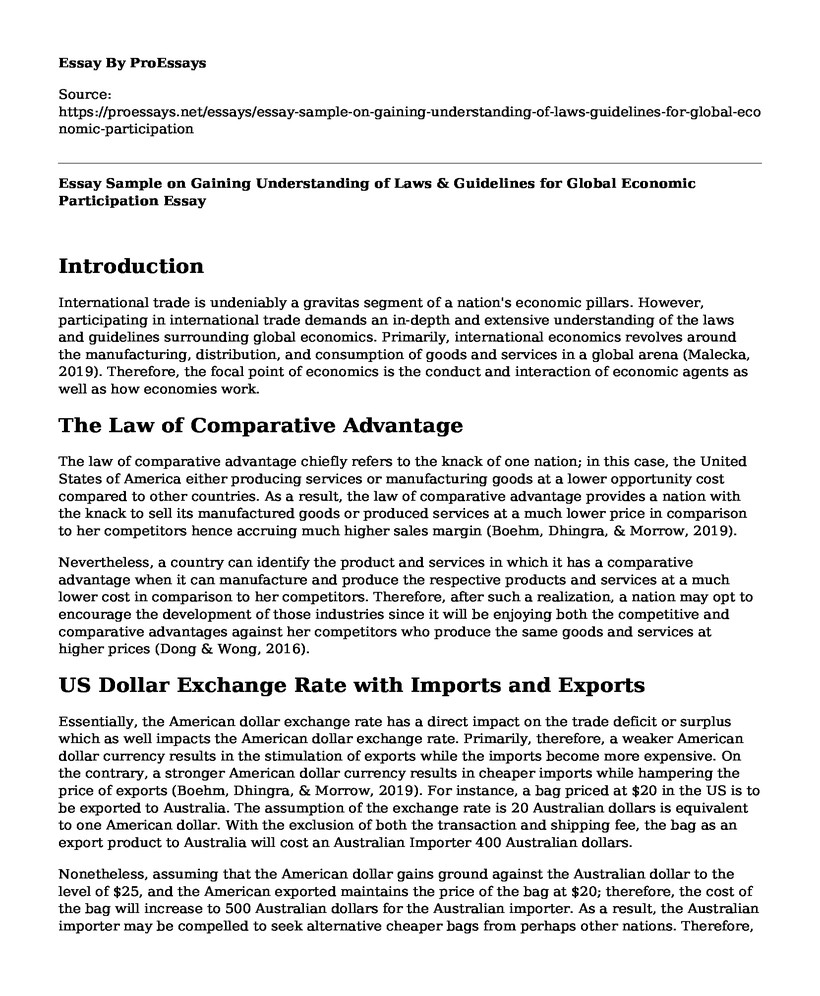Introduction
International trade is undeniably a gravitas segment of a nation's economic pillars. However, participating in international trade demands an in-depth and extensive understanding of the laws and guidelines surrounding global economics. Primarily, international economics revolves around the manufacturing, distribution, and consumption of goods and services in a global arena (Malecka, 2019). Therefore, the focal point of economics is the conduct and interaction of economic agents as well as how economies work.
The Law of Comparative Advantage
The law of comparative advantage chiefly refers to the knack of one nation; in this case, the United States of America either producing services or manufacturing goods at a lower opportunity cost compared to other countries. As a result, the law of comparative advantage provides a nation with the knack to sell its manufactured goods or produced services at a much lower price in comparison to her competitors hence accruing much higher sales margin (Boehm, Dhingra, & Morrow, 2019).
Nevertheless, a country can identify the product and services in which it has a comparative advantage when it can manufacture and produce the respective products and services at a much lower cost in comparison to her competitors. Therefore, after such a realization, a nation may opt to encourage the development of those industries since it will be enjoying both the competitive and comparative advantages against her competitors who produce the same goods and services at higher prices (Dong & Wong, 2016).
US Dollar Exchange Rate with Imports and Exports
Essentially, the American dollar exchange rate has a direct impact on the trade deficit or surplus which as well impacts the American dollar exchange rate. Primarily, therefore, a weaker American dollar currency results in the stimulation of exports while the imports become more expensive. On the contrary, a stronger American dollar currency results in cheaper imports while hampering the price of exports (Boehm, Dhingra, & Morrow, 2019). For instance, a bag priced at $20 in the US is to be exported to Australia. The assumption of the exchange rate is 20 Australian dollars is equivalent to one American dollar. With the exclusion of both the transaction and shipping fee, the bag as an export product to Australia will cost an Australian Importer 400 Australian dollars.
Nonetheless, assuming that the American dollar gains ground against the Australian dollar to the level of $25, and the American exported maintains the price of the bag at $20; therefore, the cost of the bag will increase to 500 Australian dollars for the Australian importer. As a result, the Australian importer may be compelled to seek alternative cheaper bags from perhaps other nations. Therefore, the 25% appreciation of the American dollar against the Australian dollar has led to the diminishing of America's export competitiveness within the Australian export market.
The Concept of Free Trade
In reaction as a production manager for an industry threatened by cheaper imports due to free trade, I stand to oppose uncontrolled proliferation of free trade. Firstly, the prime reason for my opposition is the need to protect my industry since unregulated free trade will provide a vast loophole for the importation of excessive goods by the nations enjoying comparative advantage, thus collapsing the domestic industry to which I belong. Additionally, it is of the critical need to shield infant industries since they lack the muscle ability to compete with these foreign comparative advantage industries (Malecka, 2019).
Conclusion
In conclusion, therefore, the protection of local industries from free trade is an unavoidable prerequisite if they are to continue in operation. More so, by protecting domestic industries from the infestation and flooding of the local market with foreign goods, employment opportunities are as well protected.
References
Boehm, J., Dhingra, S., & Morrow, J. (2019). The Comparative Advantage of Firms.
Dong, B., & Wong, S. (2016). A Theory of Comparative Advantage with Specialized Subnational Regions. Review of International Economics, 25(3), 567-577. doi:10.1111/roie.12274
Malecka, M. (2019). Economics Imperialism in Law and Economics. Encyclopedia of Law and Economics, 664-668. doi:10.1007/978-1-4614-7753-2_741
Cite this page
Essay Sample on Gaining Understanding of Laws & Guidelines for Global Economic Participation. (2023, Feb 27). Retrieved from https://proessays.net/essays/essay-sample-on-gaining-understanding-of-laws-guidelines-for-global-economic-participation
If you are the original author of this essay and no longer wish to have it published on the ProEssays website, please click below to request its removal:
- Issues to Be Addressed by United Nations Regarding Poland Paper Example
- Evaluation System in International Development Cooperation Paper Example
- A Discussion on Trade Agreements and Trans-Border Flows of Labor in Saudi Arabia
- Essay Sample on Globalization and Trade Theory
- Moral Integrity in International Organisations Paper Example
- Essay Example on ISI's Involvement in Afghanistan: Backing Up the Claims
- Research Paper on China's Growing Influence in Africa: Impact on US Trade







